Sweet potatoes are a popular vegetable, especially at holidays. They suggest images of crisp fall days, family meals, and special occasions. Sweet potatoes are an easy vegetable to grow, but they have different needs than many garden vegetables.
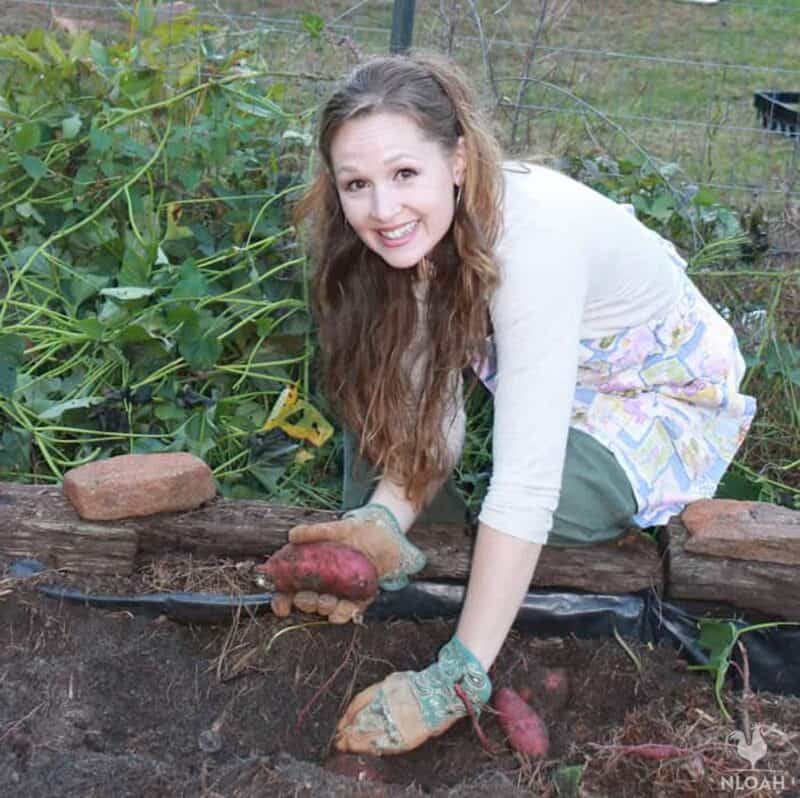
They are also one of the best yielding vegetables, producing forty to fifty pounds of tubers from one hundred feet of row space in average conditions.
Unlike most garden vegetables, sweet potatoes are a tropical plant that loves heat and cannot stand cold weather. Care is required to make sure they have good growing conditions, but homesteaders across the country can produce good crops of sweet potatoes.
Sweet potatoes can’t be treated like other vegetables, but give them what they like and you’ll get good results.
Even though they are a warm season crop, we associate sweet potatoes with fall and winter dishes. That’s because they store well. If you are careful about how the sweet potatoes are cured and stored, they will last months with little attention.
As with growing sweet potatoes, they are easy to store as long as you give them the conditions they prefer.
Table of Contents:
Sweet Potato or Yam?
Sweet potatoes are often called “yams.” Some people believe that sweet potatoes with red skin and orange flesh are yams. In fact, true yams are a tropical plant that doesn’t grow at all in the continental US.
All the sweet, creamy tubers that we eat for Thanksgiving are different varieties of sweet potato. Most Americans have never eaten a true yam at all.
Varieties
Sweet potatoes come in a range of colors, from white to yellow to orange to deep purple. The most familiar varieties of sweet potato have copper, orange, or red skin and orange flesh.
Some regions prefer yellow or white fleshed varieties. Purple sweet potatoes are relatively new in the US, but are popular in Asia.
Beauregard, Centennial, and Vardaman are the most popular orange fleshed sweet potatoes. These are the varieties you are most likely to find in grocery stores, and they will be the most familiar on the plate.
Orange varieties tend to have very sweet, creamy flesh. Traditional casserole and pie recipes work best with orange varieties.
White and yellow fleshed sweet potatoes include Nancy Hall, O’Henry, and Red Japanese. White fleshed sweet potatoes are often less sweet than the orange varieties. The flesh is somewhat drier when cooked. These varieties are good baked.
Purple varieties often have “purple” in the name, like Purple Passion, or Asian names such as Kotobuki or Okinawa. Purple sweet potatoes are rich in antioxidants. Like the white varieties, they are best baked or steamed rather than boiled.
Starting Slips
Starting sweet potatoes is different from starting almost any other vegetable. Sweet potatoes aren’t planted from seeds like most plants.
They aren’t started by planting pieces of root like white potatoes, either. Sweet potatoes are started as slips—tiny little shoots that will take root and grow in the garden.
You can order sweet potato slips from seed companies and specialty sweet potato growers, purchase the locally, or produce them yourself from mature sweet potatoes.
Follow these steps to grow your own sweet potato slips:
- Submerge the mother sweet potato in water or moist sand. The easiest way is to poke three or four toothpicks around the center of the potato and put the potato in a jar of water. The toothpicks will keep the potato from falling to the bottom of the jar. After about a week, the potato will begin putting out roots and new shoots. These shoots are the slips.
- When the slips reach 3-4 inches long, gently twist them off the mother potato and submerge them about halfway in water. The slips will also put out roots once submerged. When the roots are about two inches long, the slips are ready to plant.
- If you are trying to start slips for the first time, be careful about where you get the mother sweet potato. Grocery store sweet potatoes are often treated with chemicals to prevent sprouting, so no amount of soaking will induce the mother potato to sprout. If you are getting sweet potatoes from a friend, make sure their stand is healthy. Many sweet potato diseases are transmitted from the mother plant to the slips.
Buying Slips
Purchasing slips from certified sweet potato nurseries is a good option for starting out. Their stock is certified to be disease-free and healthy. Getting healthy plants to start with improves your odds of growing a healthy stand and having productive mother potatoes in the future.
Planting
The planting method for sweet potatoes is very different from planting white potatoes. White potatoes have enough water and energy stored that they can be planted above the ground and covered with straw while the leaves emerge.
This will not work for sweet potatoes. The slips are too fragile to survive without tight contact from moist soil.
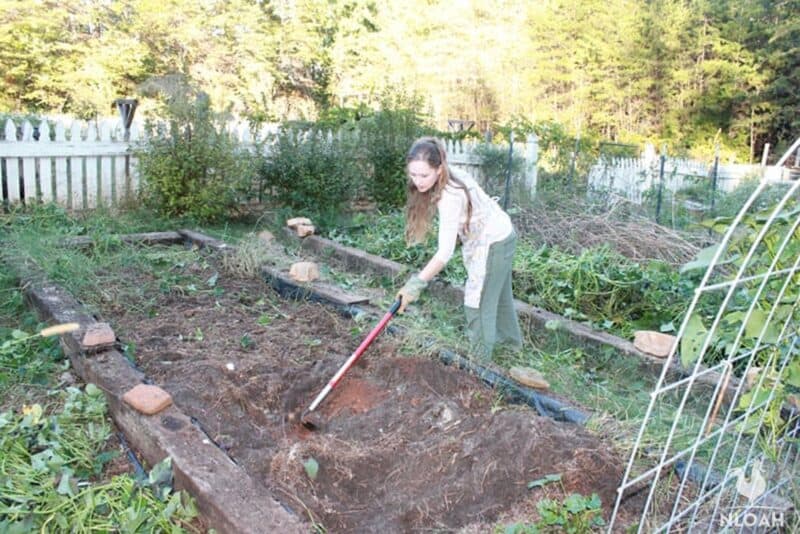
Sweet potato slips must be planted in moist soil with about an inch of stem and leaf above the ground. Water them in well and keep the soil wet until the slips start putting out new leaves.
This usually takes about a week. Once the slips are growing strongly, you can cut back on the watering.
It is best to plant sweet potato slips late in the day so that they have time start taking root overnight. It is also helpful to plant them before a run of overcast or rainy weather. In the first few days the slips are in the ground, the less full sun they get the better.
Sweet potatoes are a warm season crop. The soil temperature should be at least 60 degrees before planting the sweet potatoes. Don’t be in a rush to get them in the ground.
Nighttime temperatures below 50 can be harmful to the slips as well. I have had much better establishment rates of sweet potatoes since moving my planting dates from early April to early May. This eliminates cool nights and the slips really appreciate it.
Sweet potatoes love space. Most varieties make vines that trail all over the place. They aren’t quite as aggressive as pumpkins, but sweet potatoes are close.
Plant the potatoes on rows three to four feet apart and give each slip 12 to 18 inches of room on each side. Keep the weeds under control until the vines take off.
Sweet potatoes don’t compete well with established weeds. If you can keep the weeds from establishing themselves early, the vines will eventually smother them.
Growing
Sweet potatoes love hot weather. The ideal range for sweet potato growth is 70-85 degrees, and they will keep growing on days as hot as 95. That is why they are so popular in the south….sweet potato vines will keep going when it’s too hot for any other root crop.
Fertilizer is needed for sweet potatoes to really grow, but don’t overdo it. Give them too much nitrogen and they will make a mass of vines with practically no roots to show for it.
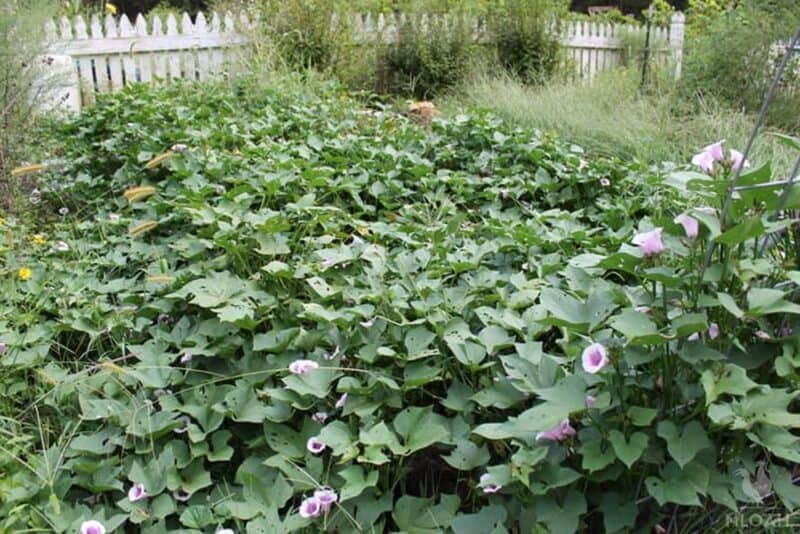
Use a fertilizer with an NPK ratio of 1:2:2 or even 1:2:4. Put out about half as much nitrogen as you would for other crops. Make sure to get all the potassium you can.
If you live in a cool climate, you can still grow sweet potatoes. It just takes a little ingenuity. Covering the soil with black plastic mulch will help it warm up faster.
If that’s not an option, make raised beds instead. Because they are exposed on all four sides as well as the top, raised beds warm up faster than flat soil.
You can also put out cold frames or low tunnels to start sweet potatoes. Keep the slips warm early so they can have a chance to get established without cold damage.
It’s not just frost you need to worry about, either. Temperatures in the 40s Fahrenheit (4 degrees Celsius) can harm sweet potato slips and really reduce your yield.
Container Sweet Potatoes
No-dig methods are popular for growing white potatoes. Since the slips need to be planted in soil to take root and grow, these soilless methods won’t work for sweet potatoes. Growing sweet potatoes in large containers is the closest you can get to a no-dig sweet potato.
If you live in a cool climate, you can use containers to extend your growing season. Start the containers in a greenhouse before it is warm enough to grow them outside.
Move the containers outside for the summer. If you think the plants need more time to grow at the end of the summer, move the containers back into the greenhouse in the early fall. This should give them plenty of time to grow big roots to eat.
Make sure to use large containers that hold enough soil to support the vines and allow room for the potatoes as well. Keep the soil moist all summer and make sure to fertilize often. Since the sweet potatoes don’t have as much soil in the containers, a steady supply of small doses of fertilizer works best.
Pests and Diseases
Along with morning glory flowers, sweet potatoes are a member of the bindweed family. This is helpful for crop rotation because sweet potatoes can follow (and be followed by) just about any other crop.
There are some nasty diseases that sweet potatoes can get, but most are limited to sweet potatoes. Just moving the sweet potato patch to the other side of the garden is usually enough to break the disease cycle from year to year.
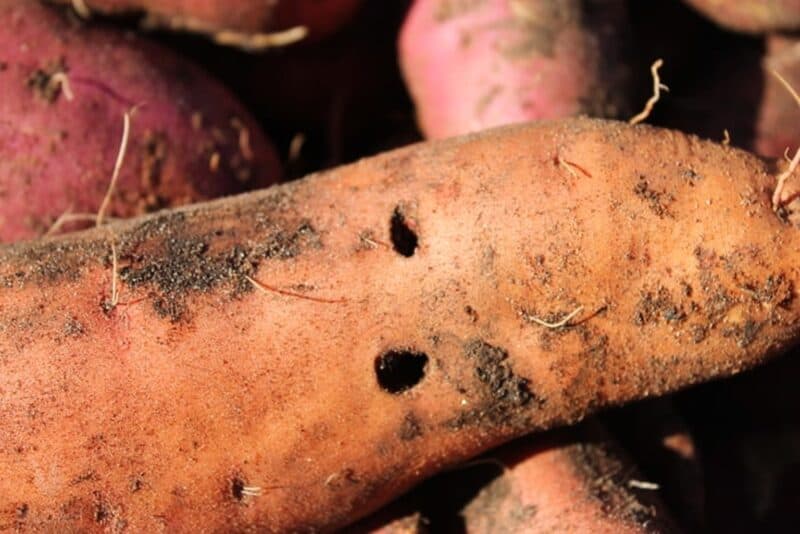
Root knot nematodes can be a problem for sweet potatoes. They are tiny worms that attack the roots of plants. Crop rotation won’t help with this problem because root knot nematodes attack most garden vegetables.
If you have root knot nematodes, look for resistant varieties of all vegetables. You can plant Sudan grass or marigolds as cover crops to help suppress the nematodes.
Above ground, sweet potatoes are attacked by flea beetles, weevils, and wireworms. Scout your plants for damage and use your favorite pest control methods.
Neem oil sprays are a good choice for pest control. Neem oil is an organic product that both repels insects from treated areas and reduces their appetite after they consume treated plants. Neem oil also helps reduce fungal infections of plants.

Harvesting
Depending on the variety, sweet potatoes take 100 to 120 days to mature. It can be difficult to know whether the potatoes are ready because they are below the ground.
Signs that the roots are ready include bulging soil around the plant and yellowing foliage. You can pull back a little soil from one or two plants to check growth progress, then gently put it back if the sweet potatoes are still small.
Make sure to harvest the sweet potatoes before any frost. If the tops freeze, it will also damage the roots. Small potatoes are preferable to inedible ones so dig the before it gets too cold.
When the sweet potatoes are ready, it’s time to dig. Use a sturdy digging fork around each plant to lift the soil and the potatoes. Gently pull the sweet potatoes from the roots and tops. Be gentle with the newly dug tubers. Until the sweet potatoes have cured, the skin is thin and fragile.
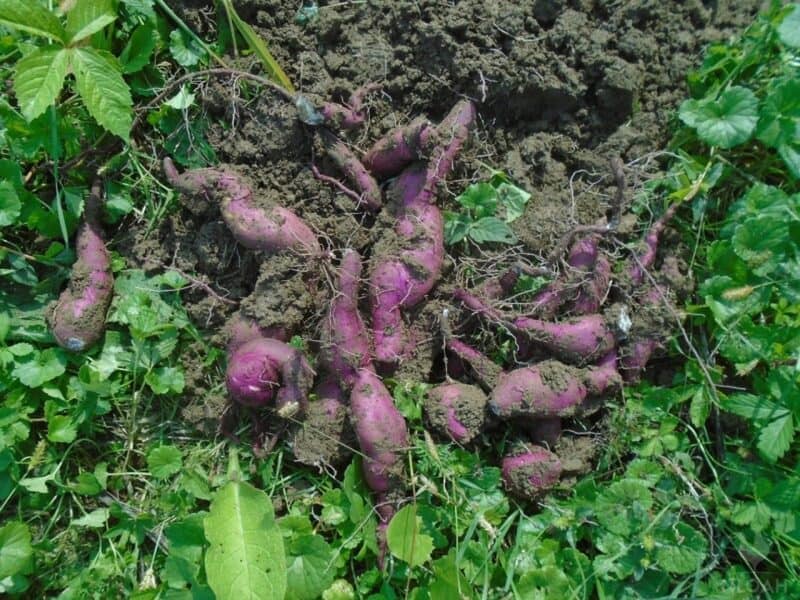
After digging the sweet potatoes, you will have a mound of vines. Sweet potato leaves are not only edible but quite nutritious. Cook the leaves using your favorite recipes for spinach, kale, or other greens.
If you don’t like greens, others around your homestead will. Most livestock and poultry enjoy sweet potato greens and will be glad to clean up the pile. If you don’t have animals, the tops make excellent compost.
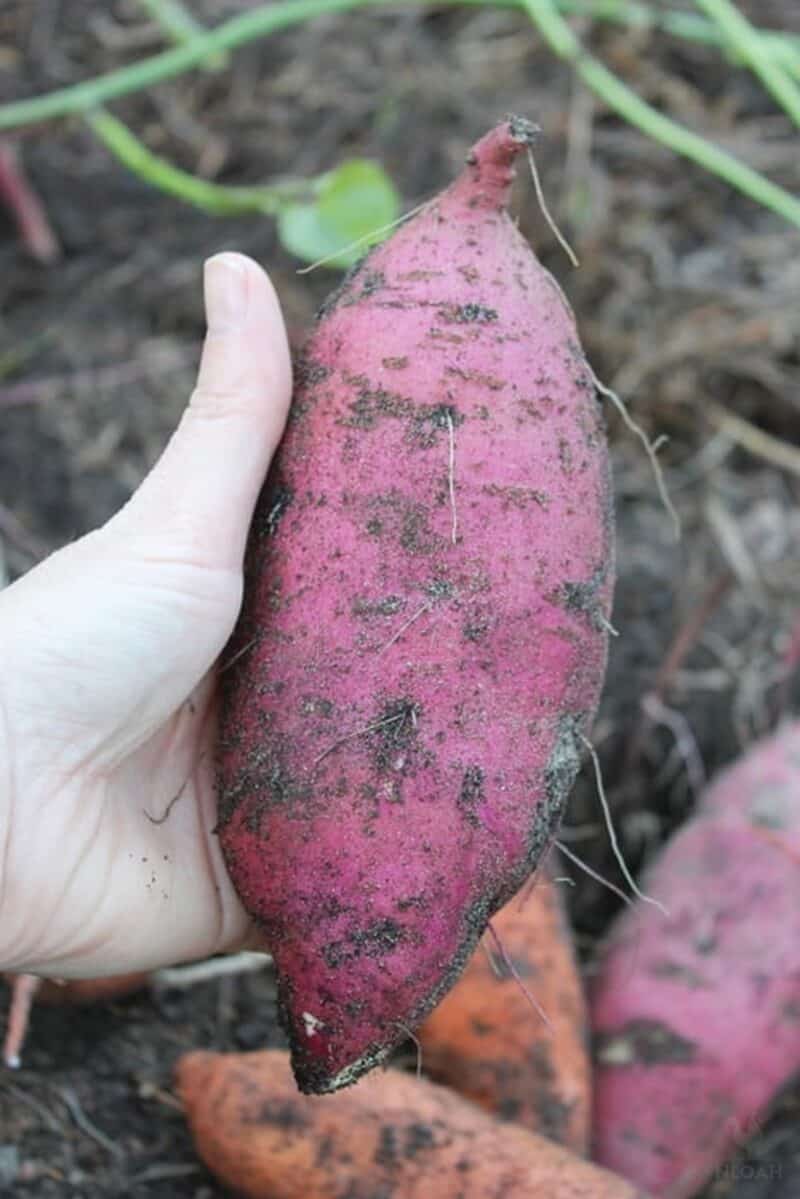
Curing
Most garden vegetables are at their best just after harvesting. Sweet potatoes are an exception to this rule. When first harvested, sweet potatoes are loaded with starch.
They will have a dull, bready flavor instead of the sweetness that gives them their name. To reach peak sweetness, sweet potatoes need to be cured. The curing process also thickens the skin and makes them ready for storage.
Don’t worry too much about cleaning the newly harvested sweet potatoes. Since the skin is so fragile, vigorous cleaning just after harvest can damage it. Brush off the biggest clumps of soil, but don’t overdo it.
Getting the sweet potatoes wet before curing can also lead to molding. After the sweet potatoes have cured, the extra soil will be dry and easy to knock off. Leaving some soil on the sweet potatoes won’t harm them in storage.
To cure sweet potatoes, store them for about a week under warm, moist conditions. The ideal is 85-90 degrees and 85-90% humidity. You can use cold frames, plastic bags in a warm window, or just a small heater, a water pan, and a tarp to get the right conditions.
Stack the sweet potatoes up, cover them to keep out light, and place a pan or bowl of water nearby to provide humidity.
After about a week, much of the starch will turn to sugar and the potatoes will be as sweet as can be. The skin will thicken and any little nicks in it will seal up. The sweet potatoes will also produce a waxy cuticle that preserves moisture and protects the flesh inside.
Storage
After the sweet potatoes have cured, it is time to store them. They need to be kept in a dark place with moderate humidity. Sweet potatoes like a warmer storage area than most vegetables; 55 degrees is ideal.
However, it is better to keep them too warm than too cold. Room temperature is fine for storage, while temperatures below 50 degrees F (10 degrees C) can cause the potatoes to develop hard spots and lose sweetness.
Keeping the sweet potatoes in a box in or near the kitchen is a good way to store them. Keeping them in a cold root cellar or garage is not. Find an out of the way place where the sweet potatoes won’t get too cold. Definitely avoid areas where they might freeze. Frozen sweet potatoes turn to inedible mush.
Cooking with Sweet Potatoes
The best-known sweet potato dishes are the super sugary casseroles and pies served at Thanksgiving dinners. Most families have a favorite sweet potato casserole recipe for holidays.
If your family doesn’t, someone you know does. Sweet potatoes can also be used in many dishes that use white potatoes. Sweet potato French fries are becoming more popular, and mashed sweet potatoes are delicious.
Smoked Sweet Potatoes
One of my favorite ways to cook sweet potato is in the smoker. I wrap whole sweet potatoes in foil and place them in the smoker at about 225 degrees along with brisket or pork shoulder.
The sweet potatoes cook all day alongside the meat. At the end of the day, the flesh of the sweet potatoes is as smooth as mashed potatoes with a delicious smoky flavor.
Sweet potatoes are a delicious vegetable that is easy to grow and to store. They have different needs than most vegetables, but they thrive in the right conditions. Put some sweet potatoes in your garden next sprint and you’ll be happy all winter long.

Aaron Cummins operates a small farm in the Cross Timbers region of Texas. He raises pastured pigs, grass-fed cattle, and vegetables. He cures pork and makes his own sausages. He enjoys hunting, fishing, and raising his three sons.

Sand Hill Preservation center in Iowa is the ultimate sweet potato source, both for knowledge and plants. They maintain a whopping 250 varieties! You can buy a al carte or they have themed samplers; short-season, purple, end-of -season clearance, etc. Just don’t try to get them on the phone and email response is slow: they are genetic preservationists and have day-jobs. This is a labor of love and duty for them. They also have every single poultry imaginable: chickens, ducks, turkey, geese, guineas, everything. They are renowned corn experts and Glenn has bred his own. They maintain a vast corn collection. Here’s the link:
https://www.sandhillpreservation.com/